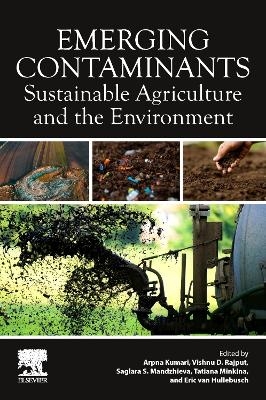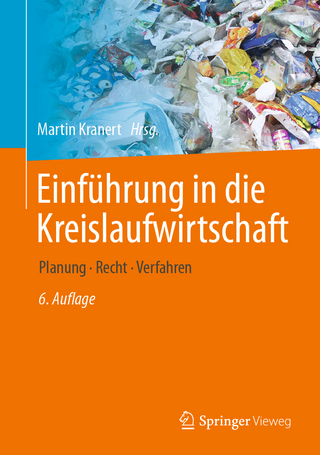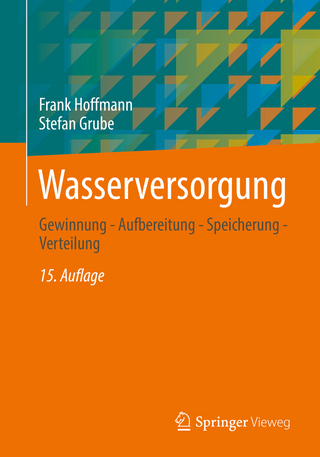
Emerging Contaminants
Woodhead Publishing (Verlag)
978-0-443-18985-2 (ISBN)
Dr. Arpna Kumari is working as a Senior Researcher in the Academy of Biology and Biotechnology, Southern Federal University, Russia. She possesses 7 years of research experience in the field of Plant Physiology with special emphasis on various abiotic stressors (i.e., drought, salinity, heat, heavy metals, organic contaminants, etc.); stress mitigation strategies; roles of nanotechnology in sustainable agriculture and contaminated soil restorations; cytotoxicity and genotoxicity of emerging pollutants. She has earned her doctoral degree in Life Sciences with specialization in Botany from Guru Nanak Dev University, Punjab, India. She has presented her research work in various national and international institutions like the National University of Singapore, National Botanical Research Institute, Panjab University, IIT-Delhi, etc. Dr. Vishnu D. Rajput is a Researcher in the Academy of Biology and Biotechnology, Southern Federal University, Russia. He has 12 years of research experiences in the field of environmental pollution especially on PAHs, priority heavy metals and metallic nanoparticles, and their impacts on plant performance, soil microbial functionalities and plant-microbe-interactions. He earned his doctorate degree from the Chinese Academy of Sciences, Beijing, China. He has published 49 peer reviewed research articles, 1 book and 8 book chapters. Dr. Rajput recently received “Highly Qualified Specialist Status by the Ministry of Internal Affairs of the Russian Federation and Southern Federal University, Russia. Dr. Saglara S. Mandzhieva is a Researcher and Head of the “Monitoring of Biosphere Laboratory of Southern Federal University, Russia. She earned her PhD in Soil Science and is currently researching biogeochemistry of trace elements in soil, environmental soil chemistry, and remediation using physicochemical treatment methods. She has published 354 scientific publications and is a member of the Eurasian Soil Science Societies and the Russian Society of Soil Science. Dr Mandzhieva is a member of various international peer-reviewed journals, including editorial board member of “Minerals. Dr. Tatiana Minkina is the Head of Soil Science and Land Evaluation Department of Southern Federal University, Russia. Her areas of scientific interest are soil science, biogeochemistry of trace elements, environmental soil chemistry and soil monitoring. In 2015, she was awarded a Diploma of the Ministry of Education and Science for many years of long-term work for the development and improvement of the educational process and significant contribution to the training of highly qualified specialists. She is a member of the International Committee on Contamination Land; Eurasian Soil Science Societies; the International Committee on Protection of the Environment; and the International Scientific Committee of the International Conferences on Biogeochemistry of Trace Elements. She has 389 scientific publications published in English and is the editor of an Open Access Journal by MDPI “Water. Eric D. van Hullebusch is a full professor in biogeochemistry of engineered ecosystems at the Institut de Physique du Globe de Paris, Université Paris Cité, France. His research is currently focusing on the implementation of biohydrometallurgical approaches for the recovery of technology critical elements (including selenium and tellurium) as well as polluted soils (bio)remediation with a particular focus on poly- and perfluoroalkyl substances (PFAS).
1. Introductory overview of emerging pollutants and challenges for environmental sustainability
2. Insights into the analytical procedures for the detection of emerging contaminants from the water, soils, and sediments
3. Occurrence of microplastics and nanoplastics in terrestrial ecosystem and their toxicological impacts in plants
4. Occurrence of emerging contaminants in soils and impacts on rhizosphere
5. Ubiquity of microplastics and phtalates in aquatic ecosystem and ecotoxicological conerns
6. Phytotoxicity, cytotoxicity, and genotoxicity of pharmaceutical products along with their transport and fate
7. Appraisal on accumulation of nano-enabled agrochemicals in plants with subsequent morpho-physiological implications
8. Endocrine-disrupting chemicals exposure induced alterations in the germination, growth, and physiological traits of plants
9. Nanomaterials induced phytotoxicity and challenges to agriculture
10. Personal care products in agroecosystem: ubiquity, sources, and toxicity insights
11. Contamination of arable soils with perfluorinated compounds and their exposure mediated modulations in plants
12. Effects of veterinary antibiotics on the soil properties
13. Pollution of silver and silver nanoparticles in the ecosystems and their interactions with plants and soil microbiota
14. Perchlorate stress in plants: Insights into growth and physiological consequences
15. Contamination of arable soils with bisphenol-A and phthalates along with their consequent impacts on the crops
16. Bioremediation of emerging pollutants: a sustainable remediation approach
17. Exploitation of plants for the removal of emerging contaminants from the environment: a green technology
18. Cyanotoxins pollution in waterbodies and soils impose potential risks to the surrounding flora
| Erscheinungsdatum | 05.03.2024 |
|---|---|
| Sprache | englisch |
| Maße | 152 x 229 mm |
| Gewicht | 690 g |
| Themenwelt | Naturwissenschaften ► Biologie ► Ökologie / Naturschutz |
| Naturwissenschaften ► Geowissenschaften ► Geologie | |
| Weitere Fachgebiete ► Land- / Forstwirtschaft / Fischerei | |
| ISBN-10 | 0-443-18985-4 / 0443189854 |
| ISBN-13 | 978-0-443-18985-2 / 9780443189852 |
| Zustand | Neuware |
| Informationen gemäß Produktsicherheitsverordnung (GPSR) | |
| Haben Sie eine Frage zum Produkt? |
aus dem Bereich


